 Abraham Lincoln is perhaps the most famous, effective, and beloved of all of the United States Presidents. His legacy really needs no introduction as he is most assuredly best known as the President who saw the country through the Civil War, bringing the North to victory in 1865. Just days later he became the first President to be assassinated. It is difficult to imagine the tumultuous times that both he and the country went through during this era. And if that isn’t quite enough, he’s the first United States President to have a beard on his face.
Abraham Lincoln is perhaps the most famous, effective, and beloved of all of the United States Presidents. His legacy really needs no introduction as he is most assuredly best known as the President who saw the country through the Civil War, bringing the North to victory in 1865. Just days later he became the first President to be assassinated. It is difficult to imagine the tumultuous times that both he and the country went through during this era. And if that isn’t quite enough, he’s the first United States President to have a beard on his face.
Perhaps his most noteworthy accomplishment was the freeing of the slaves through the Emancipation Proclamation. He was also legendary for the rags-to-riches story that brought a farm boy born in a log cabin all the way to the White House. Although shy and awkward, he was known for his inspiring speeches, particularly the Gettysburg Address which stimulated the North to victory.
Lincoln served one full term as President from 1861-65 and won election to his second term. It lasted only a month before he was shot and killed by John Wilkes Booth at Ford’s Theatre on April 15, 1865.
There are Lincoln tributes found literally all over the country, from statues to city names to locations touting that ‘Lincoln stood here’ or ‘Lincoln slept here’. Although it is still a work in progress of visiting all of the major ones, below are the actual historic sites pertaining to Lincoln that I have visited so far.
(Also see here for the Lincoln Museum of Fort Wayne, Indiana (now closed), here for the Lincoln locations at the Ohio Statehouse in Columbus, here for the Lincoln Memorial in Washington D.C, here for the statue of Lincoln on the grounds of the West Virginia State Capitol, and here for the White House of the Confederacy that was visited by Lincoln.)
Sunday, June 7, 2009 / Saturday, March 29, 2014 – Abraham Lincoln Birthplace –Abraham Lincoln was born February 12, 1809 on the Sinking Springs Farm in Hardin, County, Kentucky. The area is now part of the city of Hodgenville. The family only lived here for two years before a land dispute forced them to relocate to the Knob Creek farm about ten miles away.
Naturally the city of Hodgenville fully takes advantage of their status of Lincoln’s birthsite. Numerous businesses employ the name Lincoln. Two statues adorn the a gathering area in the center of the city, one of Lincoln the boy and one of Lincoln the man. I visited Hodegenville and the Lincoln sites here during a weekend trip through Kentucky.

The statue of the boy. I’m on the right.

The Lincoln Statue in the Hodgenville city square
Also in this town square is the Lincoln Museum. It is a good-hearted attempt at putting together various Lincoln displays without really having any genuine historic pieces. It contains several wax figures and scenes from Lincoln’s life and rather chintzy displays adorn the halls of the museum. I had to laugh when I saw a typewritten version of the Gettysburg Address hanging in a frame on the wall. Oh, well at least they’re doing something.

In front of the museum. I had to wait until 12:30 for this thing to open.
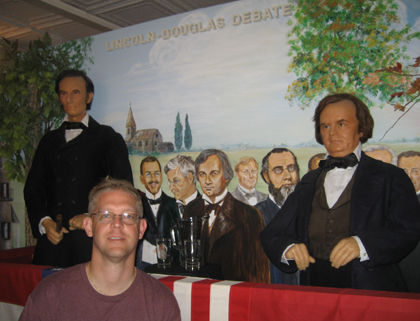
The waxy goodness of the Linclon-Douglas debates

Some of the fun to be had in the children’s section of the Lincoln Museum

Hodgenville or bust!
Near the birthsite is a visitor center that includes a theatre with a very informative 15-minute video about Lincoln’s youth entitled Lincoln: The Kentucky Years. There is one hallway which serves as a small display area with historical information, the Lincoln family bible, and a cross-section of a tree that stood near the birthplace. Outside of the center near the memorial are the so-named Sinking Springs, which in a likelihood, Lincoln had splashed in and drank from as a child.

The Sinking Springs with the Faltering Tourist

I was proud to be at the birthplace on the 200th anniversary of Lincoln’s birth

Playing with Lincoln Logs at the birthsite complex

With the Lincoln family bible, the only real piece of memorabilia to be found in the town
The Memorial to Lincoln’s Birthsite is quite impressive. The cornerstone was laid on the 100th anniversary of Lincoln’s birth by President Theodore Roosevelt and it was dedicated two years later by President William Howard Taft. Presidents Wilson and Eisenhower have also visited the location.
The symbolism in the memorial includes 16 windows, fence poles, and rosettas indicating that Lincoln was the 16th President, and 56 steps leading to the memorial symbolizing the 56 years of Lincoln’s life. Inside the building is a log cabin representative of the one in which Lincoln was born. Local tradition has long maintained that perhaps some of the logs in the cabin were from the original cabin itself, but that has been proven to be very highly unlikely.

In front of the memorial and the 56 steps leading up to it

With the representative cabin inside the memorial, leaning on one of the 16 fence poles
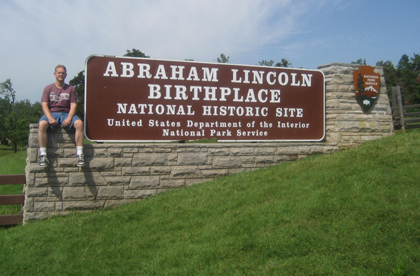
Sign at the entrace to the park
I made a return visit to the Abraham Lincoln Birthplace nearly five years later on a rainy day in late March. Carolyn and I watched the movie in the visitor center and then made a quick visit to the giant memorial. The only thing new (or at least new to me) that they had was the grave marker that of Abe Lincoln’s younger brother Thomas Lincoln Jr., who died as an infant while they were living at the Knob Creek farm. The original marker, thought to have been carved by his Abe and Tommy’s father, was originally found in the Redmond family cemetery on a knoll overlooking the farm. For a while it had apparently been on display in the Nancy Lincoln Inn near the birthplace, but is now on display in the Visitors Center.

Thomas Lincoln Jr.’s original headstone

Heading up the 56 stairs again

The representative cabin from the opposite angle

Board of Trustees plaque outside the memorial, topped by President William Howard Taft
Sunday, June 7, 2009 – Abraham Lincoln’s boyhood home at Knob Creek Farm – About ten miles northeast of the Sinking Springs Farm is the Knob Creek Farm where the Lincoln family rented and settled from 1811-1816 during which time their ownership of Sinking Springs was in dispute (the Lincolns would end up losing their claim to it).
It was on this location that Lincoln reported that he had his very earliest memories. At one point, he had fallen into a nearby creek here and was saved by his friend and neighbor Austin Gollaher. It was the Gollaher log cabin home that was relocated to Knob Creek as a representative cabin to the Lincoln family’s.
This location did not become part of the Abraham Lincoln Birthplace National Historic Park until 2001. The land was privately owned prior to this.

The entrance to Knob Creek

The historic marker at Knob Creek

Outside the Gollaher cabin, now the ‘Lincoln’ cabin
Friday, June 10, 2011 – Abraham Lincoln’s boyhood home in Lincoln City, Indiana – Obviously Lincoln City wasn’t named Lincoln City at the time, but in in 1816, President Lincoln’s father left their home in Knob Creek, Kentucky, to scout out a new place for them to live. They ended up in an undeveloped area of Indiana, where they would settle for the next fourteen years, which came to be known as Pigeon Creek Farm. Although Indiana is seldom thought of in conjunction with Abraham Lincoln, he spent his formative years here between the ages of 7 and 21.
Even more importantly, there were many events in Lincoln’s life that happened here and shaped the man that he would become. For starters, his mother passed away from a disease known as milk sickness in 1818. She would be buried on the property in a cemetery that would become known as Pioneer cemetery.

Gravestone of Abe’s mother Nancy Hanks Lincoln, placed in 1879, 61 years after her death. Yes, I leaped a fence to get in this shot.
My friend Dean and I stopped at this location as we were traveling southbound to Metropolis, Indiana. Archaeologists had excavated the hearth from the Lincoln cabin and thus the foundation has been preserved – and is inset into the ground, right where it originally was laid. Nearby is a cabin replica and a working farm with docents to show you around.

Entrance to the Lincoln Boyhood National Memorial

Plaque at the entrance of the wooded knoll that contains both the Nancy Lincoln grave site and the remains of the cabin where the Lincolns lived

The outline of the Lincoln cabin, sitting at a lower level than the surrounding land, due to the excavation to locate it

Reproduction of what the cabin might have looked like

Attacked by a cow on the Lincoln working farm
The memorial’s visitor’s center features a film about Lincoln’s time in Indian entitled Forging Greatness: Lincoln in Indiana, a small museum (which was closed during our visit), Abraham Lincoln Hall (used for church services, weddings, meetings, etc.), and on the outside, five sculpted murals depicting the stages of Lincoln’s life in Kentucky, Indiana, Illinois, Washington D.C., and…his belong to the ages.

The National Memorial Visitor Center, with the limestone mural on its walls

Mural sculpture honoring Lincoln’s life in Indiana

And now he belongs to the ages…

Lincoln City or bust!!

Fielding questions in Abraham Lincoln Hall
Dean and I spent nearly two hours here, exploring the trails, monuments, visitors center, and working farm. One other notable feature of the park was the Twelve Stones Trail, which featured twelve different stones brought to this location from other places notable in Lincoln’s life. For instance, one from Hodgenville where he was born, one from where he delivered the Gettysburg Address, and one from the White House.

From 1917-1934, this marker, located a few hundred feet from where the cabin was actually located, marked the supposed site of Lincoln’s boyhood home. Eventually the actual location was discovered during an archaelogy expedition.

One of the twelve stones along the path, this one was part of the White House
Although technically a different location, Lincoln State Park is located just across the street from the Boyhood Memorial. I decided to go ahead and pay the $5 entrance fee (after waiting an excruciatingly long time in a line of cars trying to use credit cards), just to see the Little Pigeon Baptist Church and the gravesite of Sarah Lincoln-Grigsby, Abe’s sister. Although the church sitting on the site is the third one to have been built, the first one was actually partially constructed by Abraham’s father Thomas.

The grave of Sarah Lincoln, which eclipses the grave of her husband Aaron Grigsby next to it
On the way out of the park, Dean and I also stopped to check out the nice Abraham Lincoln Bicentennial Plaza that was dedicated in 2009 – the year that celebrated Lincoln’s 200th birthday.

Bicentennial Memorial highlighting Lincoln’s height development during his 14 years in Indiana

Reverse side of the Memorial, with a not-so-proportional Lincoln bust
Saturday, June 6, 2009 – Lincoln Family locations in Kentucky – Since President Lincoln is the iconic figure that he is, even locations relevant to his wife and his parents are given memorial status in Kentucky. The following are two such locations that I have visited:
Mary Todd Lincoln Birthplace and Childhood Home – On West Short Street in downtown Kentucky stand a marker indicating the location of the birthplace of Abraham Lincoln’s wife and First Lady Mary Todd Lincoln. The original house no longer stands and another house now stands at the location.

At the location of Mary Todd Lincoln’s birth
Just one block over was the house that Mary and her family moved into when she was thirteen. This house still stands and has been restored with 85% of its original furnishings from the Todd family. They moved into the house in 1832 and Mary lived there for seven years until she moved to Springfield, Illinois in 1837. Abraham Lincoln himself visited the house during a journey with his wife from Springfield to Washington D.C. in 1847. The Todds sold the house in 1849 after the death of Mary’s father Robert S. Todd.
The Mary Todd House was opened to the public in 1977 and has the distinction of being the first National Historic Site dedicated to a First Lady. Interestingly, after the Todds left the house, for a time it became a brothel inhabited by the madam credited for inspiring the character of Belle Watling in Gone With the Wind.
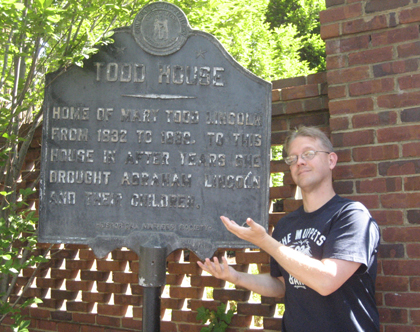
Obviously an older historic landmark found in the rear of the house. A newer one was place in front as part of the Lincoln Bicentennial celebration

In front of the Mary Todd Lincoln House
The Lincoln Homestead State Park – I swerved off toward my path to Hodgenville to visit this state park and went in cold not knowing much about it. Although Abraham Lincoln himself never lived here, the land is quite sacred in his family history. Two of the buildings located here are reproductions and two are original.

Thomas’ boyhood home (in which he lived until he was 25 years old) and the blacksmith shop where Abraham Lincoln’s father Thomas learned his trade as a blacksmith are reproductions.

Reproduction of Thomas’ boyhood home
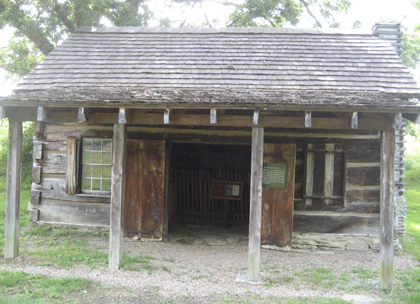
The blacksmith shop reproduction
However, the Berry home, although moved to this spot from its original location was in fact original. This log cabin was the one in which Abraham’s Mother Nancy Hanks Lincoln lived as a teenager. Abe’s father Thomas even proposed to her in this very house right in front of the fireplace. Obviously the relics inside the house are merely from the era. Still this is quite a historic building, one which would ultimately see an event that would lead to the birth of Abraham Lincoln.

Original cabin where Nancy Hanks resided

In front of the fireplace where Abraham Lincoln’s parents got engaged

Fooling around on an upstairs loom in the Berry House (so named for the Hanks in-law and owner of the house)
Just up the road from the other buildings in the Lincoln Homestead Park is the home of Abraham Lincoln’s uncle Mordecai Lincoln. As the oldest son, Mordecai had inherited the funds to buy this property from his father (also named Abraham). He lived in the house from 1797-1811.

Outside the original Mordecai Lincoln house
Finally, the park includes a memorial to Nancy Hanks Lincoln. I was rather unimpressed by not only the memorial itself, but the upkeep of it. It was merely a disheveled-looking small brick wall with a flagpole in the center…which had no flag on it! Hopefully, someone will get this cleaned up to properly honor Abraham Lincoln’s Mother.

Inscription found on the rear wall of the Nancy Hanks Lincoln Memorial
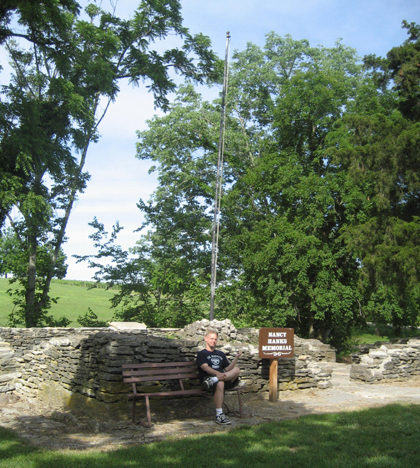
A bit of a lackluster memorial
Monday, July 21, 2014 – Lincoln’s New Salem – Abe Lincoln actually settled in New Salem before he moved to what would be his final home before the White House in Springfield. He spent about six years here working at odd jobs around the village, trying his hand at shopkeeping, and as a postmaster, surveyor, and general store co-owner. While here he served in the Black Hawk War and studied life skills including surveying.

Lincoln’s New Salem State Historic Site

With Malice Toward None…

Statue honoring Lincoln’s term as Deputy Surveyor for Sangamon County 1833-1837
New Salem was founded in 1828, and Lincoln came in 1832 on a flatboat on the Sangamon River. Lincoln ran for the Illinois General Assembly twice, losing in 1832, and winning in 1834. He moved to Springfield in 1837, having never owning a home in New Salem, but rather sleeping in various homes and shops.
Not long after Lincoln’s departure, the town began to decline with families gradually moving miles away, often literally taking their homes with them. By 1840 the entire village was abandoned. When William Randolph Hearst became fearful that the area would be destroyed for commercial development, he purchased it and put in the care of a local agency that started to rebuild it. Eventually it was put into the care of the state of Illiinois and opened as Lincoln’s New Salem Historic State Park. Only one building in the entire village is original, the Onstot Cooper Shop, although even it had been re-located and moved back.

The Henry Onstot Cooper Shop, which was originally moved from this site, but relocated back to its original foundation in 1922. This is the only original building in the park.

In 1832, Abraham Lincoln bought a share of this store with his partner William Berry. They only stayed a few months before moving across the street. This building is a reproduction on the original foundation.

Lincoln and Berry moved their business to this location in January of 1833. Amidst the merchadise, Lincoln also acted as the village postmaster out of this shop, which ended up going out of business.

Inside the second shop, and what it might have looked like
The Visitor Center included a nice museum highlighting Lincoln’s life in the village. A video film called Turning Point: Lincoln’s New Salem further explained the nature of his time here. It was fun to stroll through the village and enjoy the representative buildings and the interpreters in period garb. Because virtually none of it is original, and Lincoln didn’t exactly own a home here, it is probably one of the lesser of the Lincoln sites, but a necessary one if one want to be complete in visiting Lincoln’s homes.

Museum display inside the Visitor Center

One of the coolest relics in the museum, a compass that was used by Lincoln when he acted as Deputy Surveyor of Sangamon County
Saturday, July 19 & Sunday, July 20, 2014 – Abraham Lincoln Home and National Historic Site in Springfield, Illinois – After departing New Salem in 1837, Abraham Lincoln moved to Springfield, Illinois, and for several years he boarded with friends and stayed in country inns and farmhouses. In 1842, he married Mary Todd and they moved into the Globe Tavern, where their son Robert was born. Then they rented a small house on Fourth Street in the Fall of 1843. It wasn’t until 1844 that they purchased their own home, the only one of the Lincoln’s residences still standing today.

Photo of the house with Abraham Lincoln standing in front of it (behind the fence)

The Lincoln house today
The purchased the house from Reverend Charles Dresser, who had performed their marriage ceremony, for $1200. Originally it was only a one-story home, but the Lincolns enlarged it in 1856, adding a second floor to accomodate their growing family. The Lincolns’ next three sons were born in this house, and one, Edward, died in it. They were living here while Lincoln ran and campaigned for the Presidency and remained until they left for Washington D.C. in 1861.
Obviously the house is now a very popular tourist attraction, and tours fill up quickly. Carolyn and I got there right when the Visitor Center opened at 8:30 so that we could take the first tour at 9am. We had already watched the videos in the Visitor Center At Home with Mr. Lincoln and Homage to Lincoln the afternoon before when we arrived in town.

At the NPS sign, with the Visitor Center in the background
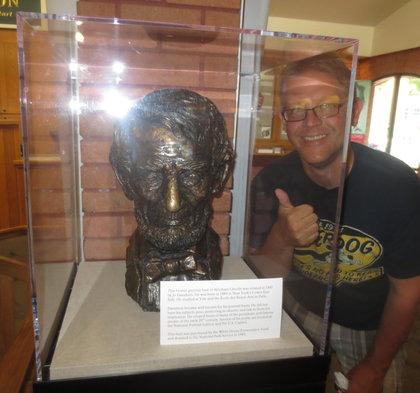
Springfield or bust!

On display is this bronze relief plaque, one of only three cast from the original plaster that sculptor Victor D. Brenner submitted to the U.S. Mint for the creation of the Lincoln penny.
The tour was short and sweet, with interpreters in each room rather than having one tour guide take you through. Photos were perfectly welcome, which is always nice. In addition to the house itself, the entire four blocks are part of the site, with several of those homes restored to the Lincoln era.

Me in front of the historic home

The Back Parlor of the house

The Lincoln bedroom

An original desk used by Lincoln

Mary Todd Lincoln’s bedroom where she would often rest during her migraine headaches

With a prop camera indicating the spot from where the most famous photos of the Lincoln house were taken. In the background are period homes that comprise the neighborhood of the historic site.
Sunday, July 20, 2014 – Other Lincoln locations in Springfield, Illinois – There is little question as to which city Abraham Lincoln considered to be his home. He stated as much when he once said, “Springfield is my home, and there, more than elsewhere, are my life-long friends.” He lived there for nearly 25 years, from 1837-1861. With the popularity of Lincoln, it is little wonder that the town itself is a virtual shrine to him. Besides his home and grave, here are a few of the other locations that I visited during my stay.

Sign at the Amtrak train station

Giant mural of a young Lincoln

One of the many Lincoln statues to be found in Springfield
The Lincoln Depot – so named because it was from this train station that Lincoln gave his farewell speech to his friends and neighbors as he boarded the train that took him to Washington D.C. on February 11, 1861, where he would be sworn in as President of the United States. The depot itself was often used by the Lincoln family throughout their stay as it was only two blocks from their house and was the easiest way in and out of town.
Although the lower level is open for tours on the weekdays, I visited on a Sunday and was therefore satisfied with photos outside.

Outside the depot

Bidding farewell from the tracks
The Lincoln Family Church – Actually the First Presbyterian Church, Abraham Lincoln and his family actually attended services in a previous building, and purchased a pew for their family for $50. The current building dates to 1868, three years after the President’s death. But it is still historically significant because it was the site of Mary Todd Lincoln’s funeral in 1888.
We visited the church on a Sunday morning actually attended the service there. We were able to see the Lincoln pew, which is stored in the narthex for all to see – but photos inside were not permitted.
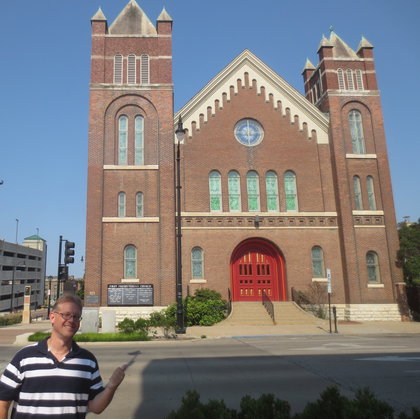
The Lincoln Family Church, where Mary Todd’s funeral took place

We attended the 10:30 service

A sneak shot of the inside of the church
The Lincoln-Herndon Law Offices – Although Abe Lincoln used several different office for his law practices during his 25-year stay in Springfield, there is only one currently still standing. The building was completed in 1841 and Lincoln moved his business into it in 1843, with his law partner Stephen Logan. Lincoln would dissolve his partnership with Logan and take in William Herndon as a junior partner in 1844. Their partnership wasn’t officially dissolved until Lincoln’s death, although they moved their practice out of the building in 1852.
The building next door was his brother-in-law’s store, and Lincoln sought refuge there from the crowds to write in inauguration speech in January of 1861.
I did not tour the location, but took photos outside the offices.

Outside the Lincoln-Herndon Law Offices

Plaque commemorating the location next door where Lincoln wrote his first inaugural speech

Statues of the Lincoln family in the plaza between the law offices and the Old State Capitol
Final Stop of Lincoln’s Funeral Train – A recent monument that has just been dedicated in 2010 indicates the location of the final stop of Abraham Lincoln’s funeral train at 9:00am on May 3, 1865. The location is currently the Amtrak station, an active railroad stop.

The most recent plaque in Springfield
Sunday, July 20, 2014 – Abraham Lincoln Presidential Library and Museum – Although not affiliated with the N.A.R.A., Lincoln’s library and museum ranks with the best of the official libraries when it comes to visuals. However, many have criticized the library for its use of theatrics over actual artifacts. It did in fact remind me more of a Disney-esque wax museum than a traditional museum. But the displays and information provided were top-rate and the presentation was quite entertaining.
The actual Library and the Museum are located in separate buildings across the street from each other. As you might guess, the library is full of books that can be accessed for research. I walked through the library and just took a couple of photos, which were only permitted in the Funeral Train area.

The Abraham Lincoln Presidential Library

The model of the Funeral Train. Note the upper levels where you can find more books than you could read in a lifetime

Close-up of the head of the Funeral Train model
The Museum was divided into several sections, with the main display areas being christened The Journey: Pre-Presidential Years and The Journey: The White House Years – each with enough wax figures to rival that of any Wax Museum. There were also two large theaters, The Union Theater, which featured an ultra-dynamic multi-media presentation called Lincoln’s Eyes, and the Holavision Theater, with a presentation called Ghosts of the Library, which is something straight out of an amusement park (in fact there is show at Knotts Berry Farm called Mystery Lodge that utilizes the same Holavision technology).

The Abraham Lincoln Presidential Museum
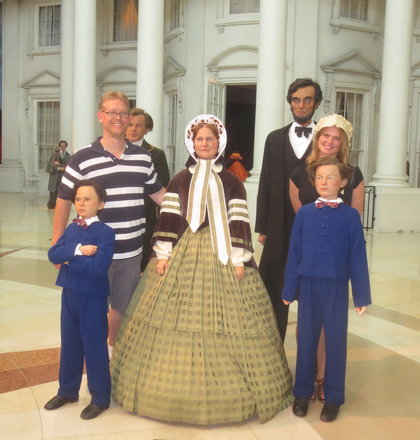
The Lincoln family…in wax. Note John Wilkes Booth in the distant background
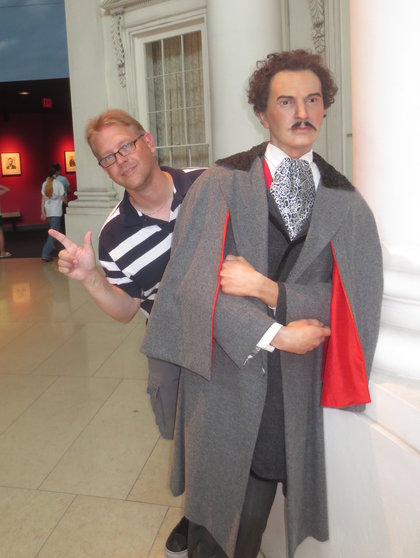
John Wilkes Booth stands by…plotting

Early Lincoln representation in the Pre-Presidential Years section

One of the coolest relics to be found: the original headstone for the grave Lincoln’s son Edward, who died at the age of three. His body was eventually moved from the Hutchinson Cemetery a few blocks west of the Lincoln home to the Lincoln Tomb in the Oak Ridge Cemetery.

Very cool dynamic map, visually showing the entire history of the Civil War

Representation of the assassination at Ford’s Theatre, as seen in The White House Years section of the museum
The Illinois Gallery features a revolving exhibit, the current of which was an Annie Leibovitz gallery called Pilgrimage. There was also a kids’ area called Mrs. Lincoln’s Attic, but the worker wasn’t too keen on Carolyn and I trying on the period clothes, so we left pretty quickly.
Overall, I enjoyed the museum immensely, but was a little bit disappointment in the lack of relics. In fact, I specifically asked about the Bible on which Lincoln was sworn into office – later used for the same purpose by Barack Obama – and it took quite a while to get an answer. But apparently it is located at the Library of Congress. It would seem that this is the better place for it…
Saturday, July 19 & Sunday, July 20, 2014 – Grave of Abraham Lincoln – On the very day of Lincoln’s death, a National Lincoln Monument Association was formed to begin raising funds for the construction of the Lincoln Tomb. Lincoln’s body traveled from Washington D.C. to Springfield in a Funeral Train making twelve stops and traveling through seven states (not stopping in New Jersey), for observation and mourning. The body returned to Springfield on May 3.
At Mary Todd Lincoln’s insistence, her husband’s final resting place would be Oak Ridge Cemetery in Springfield – although another tomb was being constructed on a six-acre block in downtown Springfield. His body was laid to rest in a receiving vault behind the monument while it was constructed. He was moved into the tomb in 1874. Between that time and 1901, Lincoln’s body was moved fifteen times due to attempts to steal his corpse and a final request from Robert Todd Lincoln that his father be buried in a steel cage surrounded by concrete ten feet below the surface of the tomb. There will be no stealing this corpse!
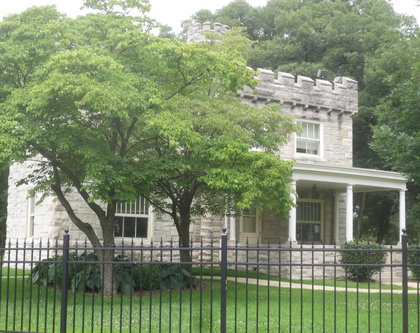
The Lincoln Tomb Custodian’s Residence – built in 1895, and housing various tomb caretakers for seventy-five years

A bronze reproduction of Gutzon Borglum’s Lincoln head from the U.S. Capitol, which many believe gives good luck to whomever rubs his nose – hence the worn down appearance and moron currently rubbing it
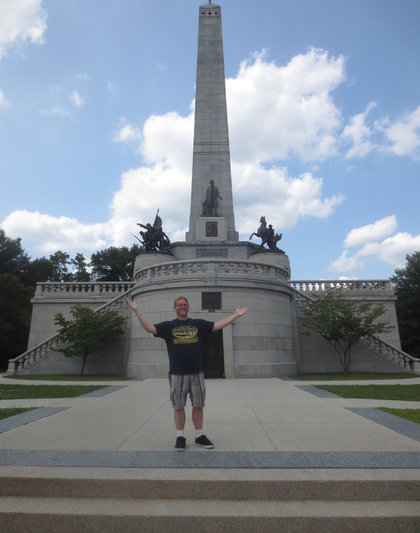
The Lincoln Tomb

Replica of the Lincoln Memorial in the tomb’s rotunda

Plaque inside the tomb’s corridor hallway

Lincoln’s sarcophogus
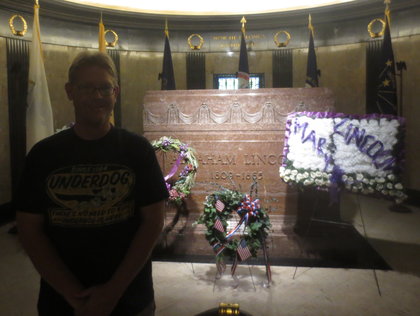
First crack at a photo of Lincoln and me
Also in the tomb are Mary Todd Lincoln, Lincoln’s two sons who died before him, Edward and Willie (who died while the President was in the White House and was originally interred in Georgetown, accompanying his father back on the Funeral Train), and Lincoln’s son Tad Lincoln who died after his father, but before his mother. Robert Todd Lincoln was temporarily entombed in the vault upon his death in 1926, but was later relocated to Arlington National Cemetery.
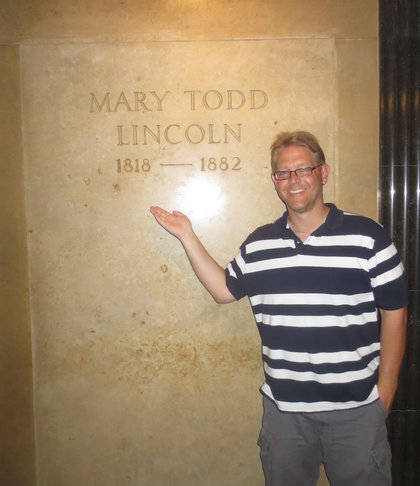
Marker for Mary Todd Lincoln

Markers for the Lincoln kids entombed in the memorial

Memorial for Robert Todd, who is buried in Arlington National Cemetery
I was quite moved by the beauty and intricacy of the tomb, which truly was a monument, complete with catacombs and statuary honoring President Lincoln. I was so taken by Lincoln’s sarcophagus that I completely missed that of First Lady Mary Todd Lincoln and the children, whose marker was behind us as we faced Lincoln’s grave. We returned the following day to observe these and get additional photos.

Honest Abe and Likewise Brad
Continue to the next President…
Return to Saturday in Kentucky 2009 …
Return to Sunday in Kentucky 2009…
Return to the 2011 road trip through Indiana…
Return to Saturday in Kentucky 2014…
Return to Saturday in Springfield 2014…
Return to Sunday in Springfield 2014…
Return to Monday in Springfield 2014…
Last year was the 150th anniversary of the Lincoln-Douglas Debates. Two wonderful re-enactors recreated the debates in each of the seven original towns on the exact anniversary dates. I was fortunate enough to witness the Jonesboro Debate on a hot day in September. The actors were marvelous and traded eloquently worded barbs along with some self effacing humor. It was a treat to see. One could almost imagine that it was the genuine event. Hurricane Ike attacked the midwest the following day. I had planned to attend the Alton Debate, as well, but my plans did not work out.
Dave Chasteen
June 15th, 2009
Supposedly Liam Neeson is playing the lead in Spielberg’s “Lincoln” biopic due out in 2011.
Peter
June 15th, 2009
As we tread nearer to the 150th Anniversary of The Civil War, I expect we will be inundated with Lincoln related media.
Adams Sandler’s film, “Happy Lincoln” is due out in early 2011. I understand he gets into a fistfight with Henry Clay in the House Chambers and loses.
Jack Black’s “Dude, I’m Abe Lincoln!” is due out late next year. According to a ‘spoilers’ website, he accidentally smokes his speech before ‘The Gettysburg Address’ and has to ad-lib it. Journalists and historians decide to re-edit his comments for the sake of The Country and posterity.
Dave Chasteen
June 15th, 2009
Is Knob Creek where they now make Knob Creek bourbon? Or maybe they named it that as some type of a Lincoln connection.
Darlene
June 16th, 2009